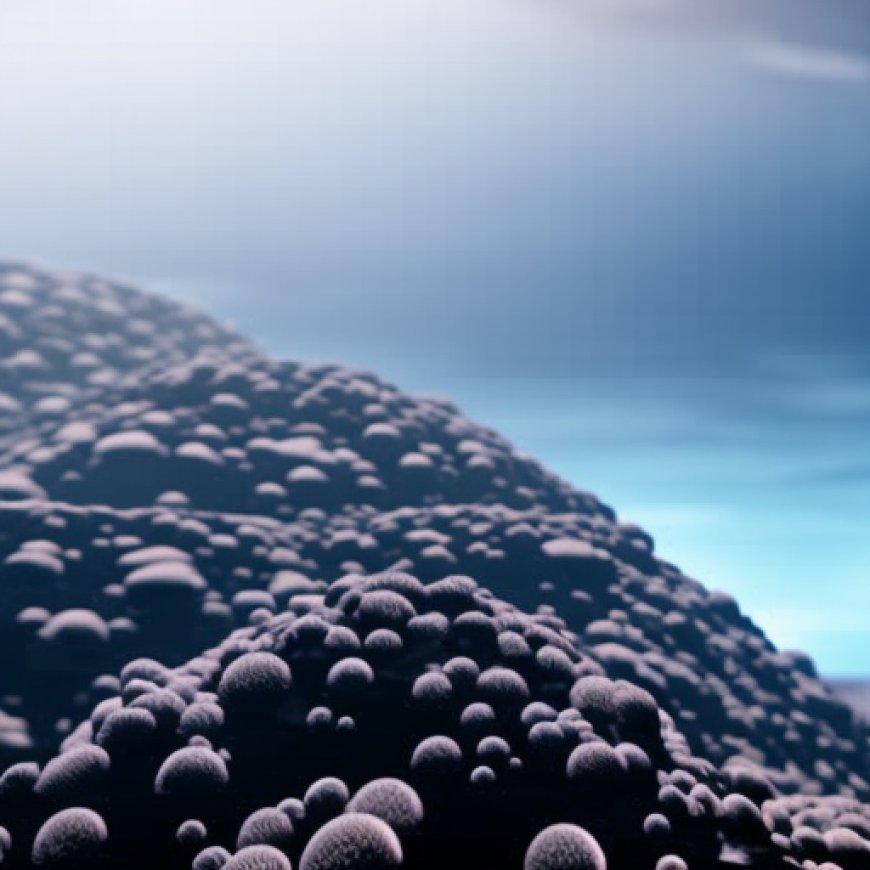Researchers identify fastest rate of natural carbon dioxide rise over the last 50,000 years
Researchers identify fastest rate of natural carbon dioxide rise over the last 50000 years Oregon State University


Atmospheric Carbon Dioxide Increase 10 Times Faster Than in the Past 50,000 Years

Corvallis, Ore. – A recent study analyzing ancient Antarctic ice has revealed that the current rate of atmospheric carbon dioxide (CO2) increase is 10 times faster than any other period in the past 50,000 years. The research, published in the Proceedings of the National Academy of Sciences, provides valuable insights into abrupt climate change periods in Earth’s history and sheds light on the potential impacts of climate change today.
Unprecedented CO2 Change
Lead author Kathleen Wendt, an assistant professor in Oregon State University’s College of Earth, Ocean, and Atmospheric Sciences, emphasizes the significance of studying the past to understand the present. She states, “The rate of CO2 change today really is unprecedented. Our research identified the fastest rates of past natural CO2 rise ever observed, and the rate occurring today, largely driven by human emissions, is 10 times higher.”
The Role of CO2
Carbon dioxide is a greenhouse gas that naturally occurs in the atmosphere. When CO2 enters the atmosphere, it contributes to climate warming due to the greenhouse effect. In the past, CO2 levels have fluctuated due to ice age cycles and other natural causes. However, today’s rising CO2 levels are primarily caused by human emissions.
Ice Core Analysis
Scientists collect ice cores from Antarctica, which contain ancient atmospheric gases trapped in air bubbles. By analyzing these ice cores, researchers can study trace chemicals and build records of past climate. The study was supported by the U.S. National Science Foundation, which funded the ice core drilling and chemical analysis.
Revealing Rapid Changes
Previous research indicated that during the last ice age, there were periods where CO2 levels appeared to significantly increase. However, the measurements were not detailed enough to fully understand the nature of these rapid changes. Wendt explains, “Our interest was piqued, and we wanted to go back to those periods and conduct measurements at greater detail to find out what was happening.”
Heinrich Events and CO2 Jumps
Using samples from the West Antarctic Ice Sheet Divide ice core, Wendt and her colleagues investigated these periods of CO2 increase. They discovered a pattern that showed these jumps in CO2 occurred alongside North Atlantic cold intervals known as Heinrich Events, which are associated with abrupt climate shifts worldwide. Christo Buizert, an associate professor in the College of Earth, Ocean, and Atmospheric Sciences and co-author of the study, states, “These Heinrich Events are truly remarkable. We think they are caused by a dramatic collapse of the North American ice sheet, setting into motion a chain reaction that involves changes to the tropical monsoons, the Southern hemisphere westerly winds, and large burps of CO2 coming out of the oceans.”
Rapid Increase in CO2
During the largest natural rises in CO2, levels increased by about 14 parts per million in just 55 years. These jumps occurred approximately once every 7,000 years. In contrast, at today’s rates, the same magnitude of increase takes only 5 to 6 years.
Impact on Southern Ocean
Evidence suggests that during past periods of natural CO2 rise, the westerly winds, which play a crucial role in the circulation of the deep ocean, were also strengthening. This led to a rapid release of CO2 from the Southern Ocean. Other research indicates that these westerlies will strengthen in the next century due to climate change. The new findings suggest that this strengthening will reduce the Southern Ocean’s capacity to absorb human-generated CO2.
Sustainable Development Goals
- Goal 13: Climate Action – The study highlights the urgent need for climate action to address the unprecedented rate of CO2 increase and its potential impacts on the environment.
- Goal 14: Life Below Water – The findings emphasize the importance of protecting the Southern Ocean and its ability to absorb CO2 to maintain a healthy marine ecosystem.
- Goal 15: Life on Land – Understanding past climate changes and their effects on land ecosystems is crucial for sustainable land management and conservation efforts.
Conclusion
The research on the rapid increase in atmospheric CO2 provides valuable insights into Earth’s past climate changes and their implications for the present. The unprecedented rate of CO2 increase underscores the urgency of taking climate action to mitigate its potential impacts. Protecting and preserving the Southern Ocean’s capacity to absorb CO2 is crucial for achieving sustainable development goals related to climate action, life below water, and life on land.
Additional Coauthors
- Ed Brook
- Kyle Niezgoda
- Michael Kalk
- Christoph Nehrbass-Ahles
- Thomas Stocker
- Jochen Schmitt
- Hubertus Fischer
- Laurie Menviel
- James Rae
- Juan Muglia
- David Ferreira
- Shaun Marcott
SDGs, Targets, and Indicators
| SDGs | Targets | Indicators |
|---|---|---|
| SDG 13: Climate Action | Target 13.1: Strengthen resilience and adaptive capacity to climate-related hazards and natural disasters | Indicator not mentioned in the article |
| Target 13.2: Integrate climate change measures into national policies, strategies, and planning | Indicator not mentioned in the article | |
| Target 13.3: Improve education, awareness-raising, and human and institutional capacity on climate change mitigation, adaptation, impact reduction, and early warning | Indicator not mentioned in the article | |
| Target 13.a: Implement the commitment undertaken by developed-country parties to the United Nations Framework Convention on Climate Change to a goal of mobilizing jointly $100 billion annually by 2020 from all sources to address the needs of developing countries in the context of meaningful mitigation actions and transparency on implementation and fully operationalize the Green Climate Fund through its capitalization as soon as possible | Indicator not mentioned in the article | |
| Target 13.b: Promote mechanisms for raising capacity for effective climate change-related planning and management in least developed countries and small island developing States, including focusing on women, youth, and local and marginalized communities | Indicator not mentioned in the article | |
| SDG 14: Life Below Water | Target 14.3: Minimize and address the impacts of ocean acidification, including through enhanced scientific cooperation at all levels | Indicator not mentioned in the article |
| Target 14.7: By 2030, increase the economic benefits to Small Island Developing States and least developed countries from the sustainable use of marine resources, including through sustainable management of fisheries, aquaculture, and tourism | Indicator not mentioned in the article | |
| Target 14.a: Increase scientific knowledge, develop research capacity, and transfer marine technology, taking into account the Intergovernmental Oceanographic Commission Criteria and Guidelines on the Transfer of Marine Technology, in order to improve ocean health and to enhance the contribution of marine biodiversity to the development of developing countries, in particular small island developing States and least developed countries | Indicator not mentioned in the article | |
| Target 14.b: Provide access for small-scale artisanal fishers to marine resources and markets | Indicator not mentioned in the article |
1. Which SDGs are addressed or connected to the issues highlighted in the article?
- SDG 13: Climate Action
- SDG 14: Life Below Water
The article discusses the rapid increase in atmospheric carbon dioxide and its potential impacts on climate change, which aligns with SDG 13. The mention of ocean acidification and the impact on marine resources also connects to SDG 14.
2. What specific targets under those SDGs can be identified based on the article’s content?
- Target 13.1: Strengthen resilience and adaptive capacity to climate-related hazards and natural disasters
- Target 13.2: Integrate climate change measures into national policies, strategies, and planning
- Target 13.3: Improve education, awareness-raising, and human and institutional capacity on climate change mitigation, adaptation, impact reduction, and early warning
- Target 13.a: Implement the commitment undertaken by developed-country parties to the United Nations Framework Convention on Climate Change to a goal of mobilizing jointly $100 billion annually by 2020 from all sources to address the needs of developing countries in the context of meaningful mitigation actions and transparency on implementation and fully operationalize the Green Climate Fund through its capitalization as soon as possible
- Target 13.b: Promote mechanisms for raising capacity for effective climate change-related planning and management in least developed countries and small island developing States, including focusing on women, youth, and local and marginalized communities
- Target 14.3: Minimize and address the impacts of ocean acidification, including through enhanced scientific cooperation at all levels
- Target 14.7: By 2030, increase the economic benefits to Small Island Developing States and least developed countries from the sustainable use of marine resources, including through sustainable management of fisheries, aquaculture, and tourism
- Target 14.a: Increase scientific knowledge, develop research capacity, and transfer marine technology, taking into account the Intergovernmental Oceanographic Commission Criteria and Guidelines on the Transfer of Marine Technology, in order to improve ocean health and to enhance the contribution of marine biodiversity to the development of developing countries, in particular small island developing States and least developed countries
- Target 14.b: Provide access for small-scale artisanal fishers to marine resources and markets
3. Are there any indicators mentioned or implied in the article that can be used to measure progress towards the identified targets?
No, the article does not mention or imply any specific indicators that can be used to measure progress towards the identified targets.
Copyright: Dive into this article, curated with care by SDG Investors Inc. Our advanced AI technology searches through vast amounts of data to spotlight how we are all moving forward with the Sustainable Development Goals. While we own the rights to this content, we invite you to share it to help spread knowledge and spark action on the SDGs.
Fuente: today.oregonstate.edu

Join us, as fellow seekers of change, on a transformative journey at https://sdgtalks.ai/welcome, where you can become a member and actively contribute to shaping a brighter future.







